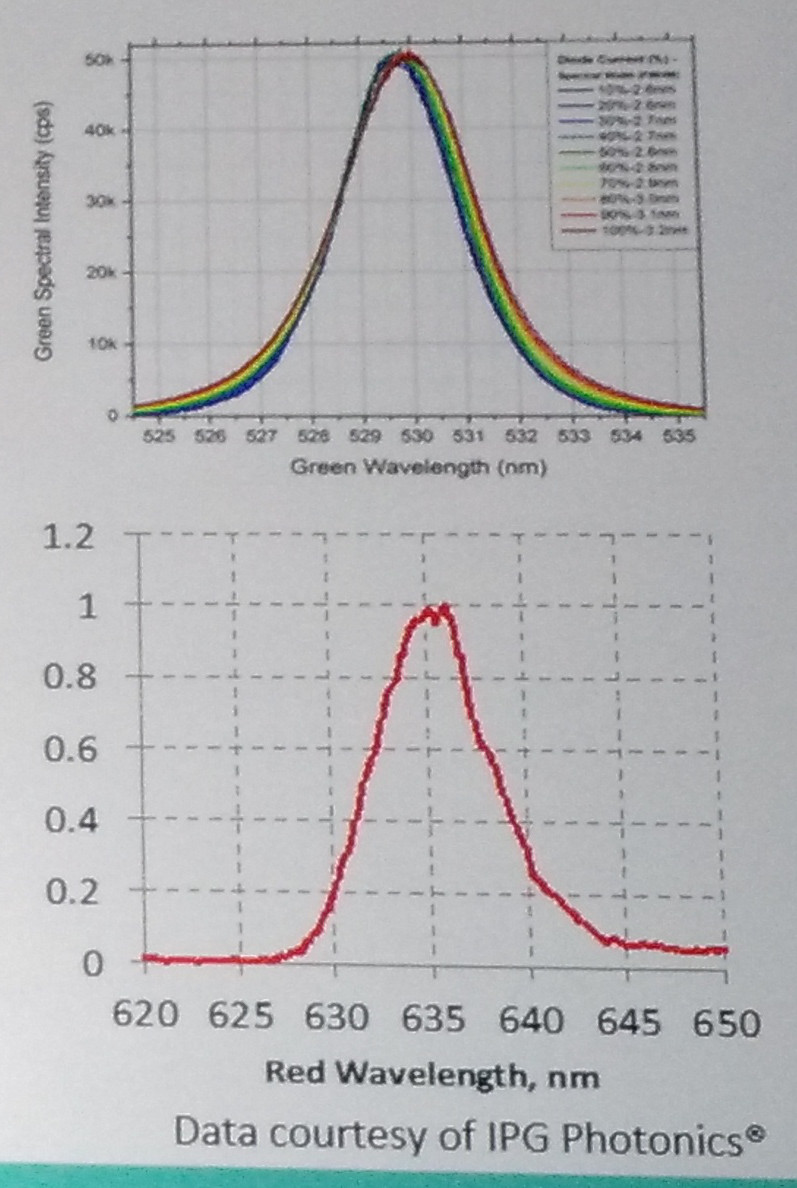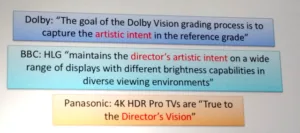Frank Poradish of Brass Roots Technology gave an overview of the evolution of digital projection in the cinema touching on the latest trends in resolution, higher contrast, laser illumination, higher frame rates and wide color gamut. His most curious comment was that “bad lasers may be the best.” By this, he meant that conventional laser developers focus on single frequency, single mode lasers – which are exactly the opposite of what is desired for laser projection. Some spectral diversity in the wavelength is needed for speckle reduction – or a bad laser. He noted that the RGB laser source in the new NEC3540L comes from a company called IPG Photonics. They make all kinds of lasers for a variety of applications, but developed a new fiber laser for the digital cinema industry that meets Poradish’s definition of a bad laser.

There was a lot of discussion about which comes first: the HDR grade or the SDR grade. Whichever one is done first, transforms can be used to create an initial version of the other, but a trim pass will always be required to fine tune it.
Supporters of the HDR first say this is best as you sometimes see things in the HDR version that you missed in the SDR grade, which may have impacted your creative choice. Also, generating the SDR from the HDR creates a better SDR master, and your “hero” archive version is the best quality HDR master.
Supporters of the SDR first focus on practicalities. Most theaters are SDR so you need to be sure that the biggest installed base gets the movie in time before turning to the specialty HDR venues.
There remain some issues in going with the HDR first route. For one, the installed base of theaters is small – there are only about 100 HDR theaters today, and the current pipeline for movie production (on set, dailies, editing, etc.) is SDR. More HDR monitors and equipment is needed to enable this transition.
There was also some discussion of whether the home grade, which will be higher luminance, should be the hero version and the first to grade. Most at the event could not go along with that notion as they are in parts of the business where theatrical movies are their primary product and will always be first in line.
But other content creators, like Netflix, are optimising all of their content HDR first.
This debate will continue and likely transition from SDR first to HDR first as the HDR installed base increases and HDR equipment becomes more widely available.
There was a whole session devoted to “maintaining artistic intent.” This desire clearly drives everyone in the content creation community where they often obsess over minute details in pursuit of artistic intent. Dolby’s Pat Griffiths first asked if anyone thought the consumer cared about artistic intent and no one raised their hands. He then asked if we should use the term creative intent, artistic intent, director’s intent or storyteller’s intent to describe what the whole value chain does in trying to make the best movie possible. The crowd seems to settle on storyteller’s intent.
But can storyteller’s intent be maintained in the home? All agreed that was nearly impossible as it is not a controlled environment and there is a huge variety in the capabilities of TVs in the home.
Neil Robinson of LG Electronics noted that LG has two cinema modes in their OLED TVs. Regular cinema mode is a faithful calibrated mode designed for dark room viewing. The cinema home mode raises the average picture level to account for the ambient illumination found in most living rooms. This is tied into the light sensor in the TV.
Dominic Glynn from Pixar Animation said that they include an optimizer clip on all of their packaged media for the home. This is a tutorial to help the consumer set up the TV in the best way to view the Pixar movie. It recommends things like turning off motion interpolation, setting into cinema or movie mode, etc.
Griffis wondered if there might be some interest in having celebrities doing some public service announcements regarding maintaining storyteller’s intent? That got a positive reaction from LG’s Robinson, but he acknowledged he is not the decision maker. He did recommend more communication between CE device makers and content creative community so storyteller’s intent can be better maintained across platforms. This includes mobile which is a huge platform that can’t be ignored
In another session, Annie Chang of Marvel said that they think that the new Guardians of the Galaxy movie is the first one to be processed in the ACES workflow with HDR and a Dolby Vision output. To create the Dolby Vision version, they first needed to create an output transform to map from the ACES color space to BT2020 and the luminance range for Dolby Vision. They worked with Technicolor and Deluxe and after several iterations, found one that all liked. This configuration will now be used by Deluxe on the next Spiderman movie.
Here is an interesting factoid. The combined production budget for Amazon and Netflix in 2017 is nearly $12B – that’s almost the same as the entire US movie box office take, so you can see how much of an impact these two are having. – CC

